|
|
|
|
|
Team Group C440 Cardea Ceramic M.2 NVMe SSD |
|
Join the community - in the OCAU Forums!
|
Today on the (somewhat dusty) testbench we have the Cardea Ceramic C440 M.2 NVMe SSD from Team Group. Team Group are a very widely-recognised brand now, having been around since 1997. In the recent past I've reviewed their Vulcan 2.5" SSD, Vulcan SO-DIMM DDR4, MP34 M.2 SSD and RGB 2.5" SSD. Recently they announced what they're calling the first DDR5 DIMMs for the desktop. Anyway, today's offering is a Gen4 x4 PCIe NVMe SSD, which promises quite a boost in performance over Gen3 drives if your system supports it. This drive also features a thin ceramic heatspreader which gives it an unusual white appearance. We have the 1TB unit here but it's also available in 2TB.
The packaging has changed a bit since the MP34 I reviewed in 2019. They've moved from a small cardboard box to a thin cardboard sleeve. You need to cut the top off the cardboard to release the plastic clamshell containing the drive. Inside is simply a small warranty leaflet, a case badge I only found later, and the drive itself.
 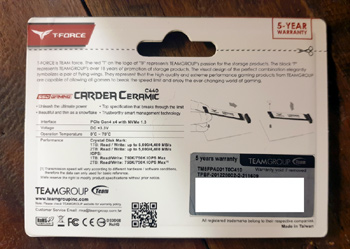
The drive looks quite smart with its thin white heatspreader. The ceramic side of things is a little confusing as I've always considered ceramic to be an insulator rather than a conductor. Also with the heatspreader only on one side (no doubt due to limitations in mounting height) it's hard to see how effective it can be if the chips on the far side are overheating. But this is true of all heatsink-equipped M.2 drives, so we can't judge Team Group too harshly here.
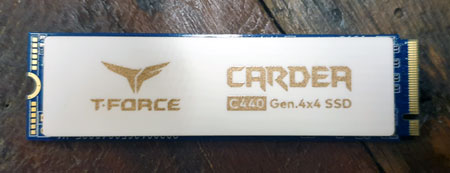
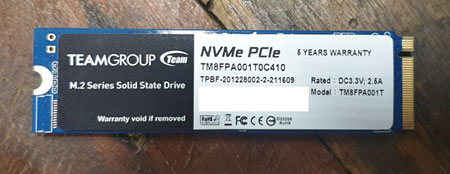
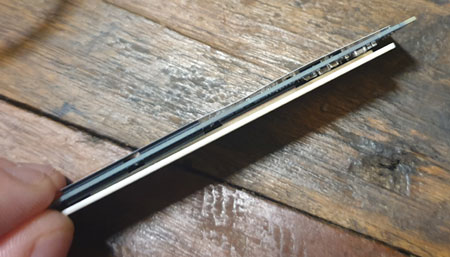
This is the first PCIe Gen4 NVMe SSD I've had a chance to play with, so we'll be comparing it to Gen3 NVMe drives. This will give an idea of what general improvements might be expected between those generations of drives. So for comparison we have the Team Group MP34 512GB I reviewed here and the Crucial P1 1TB I reviewed here. It's worth noting that both of these drives have been in my main desktop PC for a while, so they aren't fresh out of the box like the Cardea we're reviewing. CrystalDiskInfo reports them both as "healthy" though, with 99% for the Team Group and 100% for the P1. They are also both a bit under half full, so bear that in mind. Later on after migrating my data from the Crucial P1 to the C440 Cardea, I ran another set of benchmarks with the latter drive at 66% full, so those are included for further comparison.
Finally, as an oddball inclusion we also have my S: drive, which is a software RAID0 array made up of three 240GB 2.5" SATA SSDs I had lying around. They're all plugged into SATA headers on the motherboard and simply combined in Disk Management under Windows 10. These are significantly less healthy, all reporting around 74%, presumably as a direct result of having been the temp folder for me plotting nearly 200 chia plots. I'll explain more about chia later, but suffice to say these drives have had a pretty rough couple of months.
Installation and Benchmarks:
Installation was very simple, slotting the drive into the lower of the two M.2 slots on my Gigabyte X570 Gaming X motherboard. This system has a Radeon 9 3900X CPU and 32GB of DDR4-3200 memory. The drive draws the eye with its white heatspreader once installed, and would certainly look the part in a build featuring other white components. As opposed to, say, a 22-year old beige minitower.
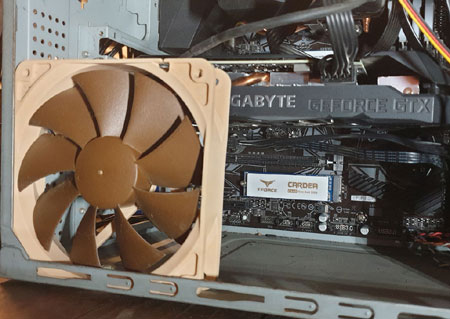
Time for the benchmarks. First up we have the traditional favourite, CrystalDiskMark. I chose "NVMe SSD" mode under Settings, but otherwise took the defaults.
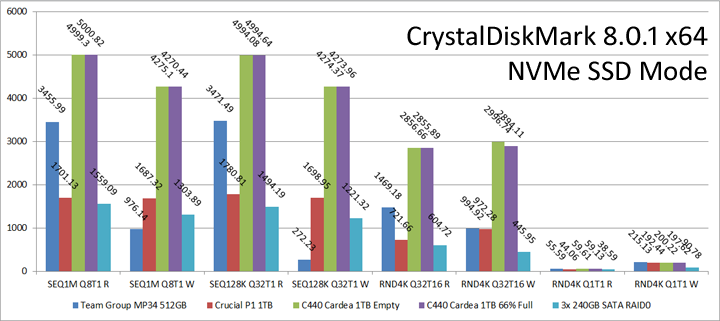
The C440 Cardea very clearly beats the other drives across the board. The PCIe Gen3 MP34 512GB just about holds its own in the sequential read tests, but in the writing and random tests the Cardea is more than twice as fast. Interestingly there's virtually no difference in performance from the Cardea at empty or 66% full.
Next, a simple copy-to-self test. In this test I copy a given set of data from a directory to another directory on the same drive. I delete the copy and copy it again, timing it both times with the stopwatch function of the clock in Windows 10. An average of those two runs is recorded. The data set contains a range of large, medium and small files - a mix of installation directories, PDFs, documents and spreadsheets, thousands of images, large media files and zip archives. In total about 101GB in 15,598 files. This is enough to exhaust any caches and show us the real speed of the drive across a variety of workloads.
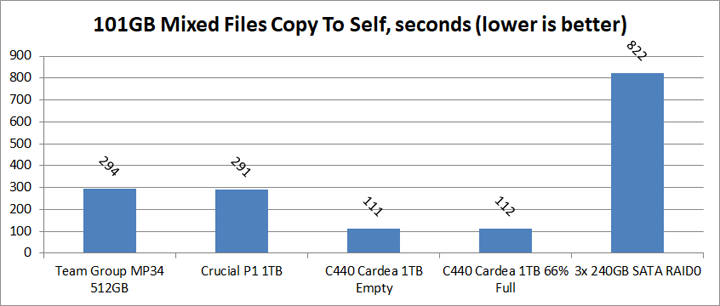
All drives slowed significantly while copying many small files and sped up while copying large files. The Cardea peaked at 1.67GB/s and overall it took only about a third as long as the other two M.2 drives - and thrashed our oddball 3x 240GB SATA RAID0 array. Again there was no significant difference between empty and full with the Cardea.
Finally, I used each drive as the temporary folder for creating a chia plot. I'm not going to go into too much detail, but chia is a cryptocurrency that relies on disk space rather than the computational effort used by Bitcoin and Ethereum. Chia plot files are normally 101GB in size and the process to create them basically hammers your storage for a few hours, with nearly 300GB of writes. So, this storage-intensive task seemed an ideal benchmark. For those in the know, we are only timing Phase 1 of the plot creation, because that is the most intensive part and also has a nice clear entry in the logfile reporting exactly how many seconds it took. It's a normal k=32 plot with 4 threads and 8000MB of memory allocated, using the default plotter rather than Mad Max, in chia 1.1.7. Also, if you do happen to have gone a bit nutty for chia, Team Group have a chia-optimised M.2 drive now.
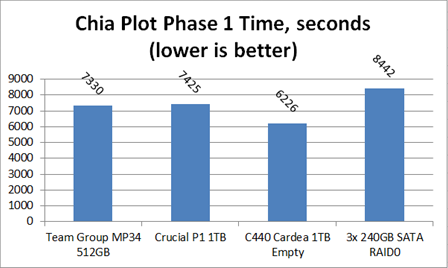
I didn't include a result with the Cardea at 66% full this time as there'd been no difference in the previous results, and also I don't want to needlessly thrash this shiny new drive with chia work. But unsurprisingly we see it handily beating the other drives even in this very intensive sustained workload. Across the board, the Cardea C440 has firmly established itself as the quickest single-drive storage I've ever used.
Heat?
But what about the fancy heat-spreader? In the testbed PC I have a slow-spinning Noctua 120mm fan blowing towards that part of the case because usually this machine is GPU mining with two GPUs. So, I left that fan in place with the lower GPU removed for the duration of testing, and kept an eye on temperatures using CrystalDiskInfo. The highest I saw the Cardea get to was 47C, curiously a couple of minutes after finishing the copy-to-self test. It started at 30C, slowly rose to about 42C as the test progressed, continued to rise after the test to 47C, then dropped quite rapidly back down to 30C again after a minute or so. Under the same test, in the same slot with the same cooling, the P1 1TB followed a similar pattern but peaked at 51C. It's difficult to say whether that difference is due to the ceramic heat-spreader, or just generational or technological differences between the two drives. However, given Team Group rate their drive's operational temperature to 70C and there was certainly no evidence of thermal throttling during the test, I remain as unconcerned about SSD temperatures as I have always been. It's probably a good idea to cool them actively if you are going to be thrashing them continuously, but for general use they should be fine with whatever airflow happens their way.
Warranty and Endurance:
It's worth pointing out that for general use, any NVMe M.2 drive is going to serve you pretty well. If you've ever upgraded a PC from an old spinning-rust HDD to a 2.5" SSD, you will have felt that immediate improvement in usability. NVMe drives add another order of magnitude to that, but I doubt you'd notice too much real-world difference between a PCIe Gen3 drive and a Gen4 one. Maybe it would save a few seconds if you were loading a massive game off the drive, but unless you are habitually moving huge amounts of data back and forth there's probably not too much in it.
One way Team Group distinguish themselves in such a market is their 5-year warranty. To back that up, they rate the 1TB version of this drive to 1800 TBW. From a quick look at competing brands, 1200TBW is quite common, but 1800W is up there among the highest endurance ratings of 1TB M.2 drives. So Team Group are not causing me any alarm there.
Conclusions:
I couldn't actually find a price in Australia for the Team Group Cardea C440, but from past experience Team Group have always priced themselves competitively. Similarly, I'm a little reluctant to glowingly recommend this drive given it's the first Gen 4 PCIe drive I've had a chance to play with. However, what we do know is this: it performed admirably in every test I threw at it, being by far the fastest single-drive storage I've ever used. It comes with an appealing endurance rating and warranty, and it looks pretty neat. So it's definitely worth having on your short list when you're next shopping for storage.
One final thing I wanted to note about M.2 drives is their flexibility. Sure, we can use them in laptops and PCs with M.2 slots built in, but when you couple them with a cheap PCIe adapter they open up a world of options for other PCs. For example, I have an old HP MicroServer N36L - the original model. It has four 3.5" drive bays, but once you've filled those, and like most people repurposed the DVD's SATA connector for an SSD, how do you add more fast storage? An M.2 SSD in a PCIe adapter card is a great solution.
More interestingly, I also have a Dell R610 1RU rackmount server here, that used to host OCAU for many years but now is just used for testing. If I want to add more storage to that machine, I have to dive into the world of 2.5" SAS drives - which isn't such a big deal but isn't very flexible. However it has vacant PCIe slots, so it's easy enough to add a couple of M.2 drives in PCIe adapters and hugely expand its storage. That is in fact where my old P1 drive has ended up, because the Cardea C440 has taken its place in my daily driver PC. I'll use the Cardea for general download and file management type duties, but also to house my Steam library - where the extra speed will certainly help.
Thanks to Team Group for the opportunity to review this drive! Feel free to discuss this review in this thread.
|
|
Advertisement:
All original content copyright James Rolfe.
All rights reserved. No reproduction allowed without written permission.
Interested in advertising on OCAU? Contact us for info.
|

|


